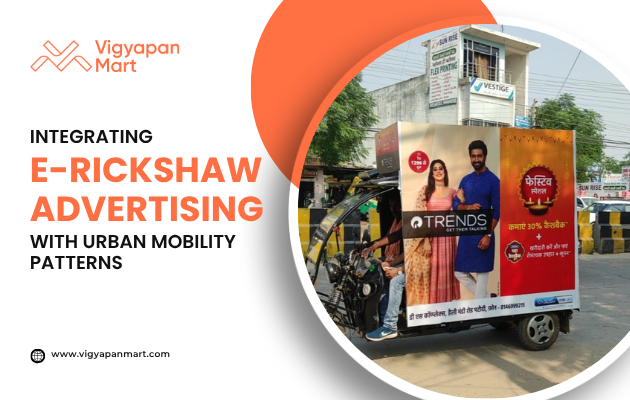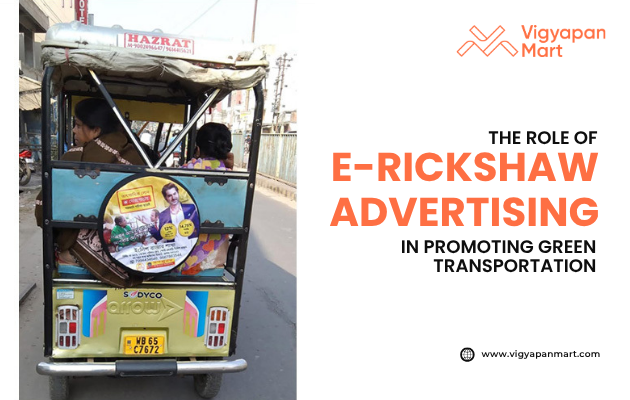Integrating E-Rickshaw Advertising with Urban Mobility Patterns

Imagine walking through a busy city street. Everywhere you look, there are people, shops, and vehicles. Among these, you notice a colorful three-wheeled vehicle—an electric rickshaw, or e-rickshaw. These small, eco-friendly vehicles are more than just a way to get around. They are becoming a powerful way for businesses to share their messages with the world. This blog will explain how e-rickshaw advertising fits into the way people move in cities. We will look at why it works, who sees it, and how it helps cities become cleaner and greener.
What is E-Rickshaw Advertising?
E-rickshaw advertising means putting ads on electric rickshaws. These ads can be on the sides, back, or even cover the whole vehicle. Some ads use bright lights or moving screens to grab attention, especially at night or on cloudy days
What are e-rickshaws?
- Three-wheeled, battery-powered vehicles.
- Used for short trips in cities and towns.
- Popular in India, Bangladesh, and Nepal.
Why use them for ads?
- They move through crowded streets, markets, and busy areas.
- Many people see them every day.
- They are affordable and eco-friendly.
How E-Rickshaw Advertising Fits with Urban Mobility
Urban mobility means how people and vehicles move around in cities. In big cities, people move in many ways: by walking, cycling, buses, cars, and now, e-rickshaws.
E-rickshaws in city traffic
- They fit in narrow streets and heavy traffic.
- They help people go short distances, like from home to the market or bus stop.
- They are especially important in places where buses or trains do not go.
Advertising on the move
- E-rickshaws with ads are like moving billboards.
- They reach people on the street, in cars, or waiting at bus stops.
- They travel through busy areas, so lots of people see the ads.
Benefits of E-Rickshaw Advertising
E-rickshaw advertising is good for businesses and for cities.
High visibility
- E-rickshaws move through crowded places.
- Ads are seen by pedestrians, drivers, and passengers.
Cost-effective
- Cheaper than TV or big billboards.
- More people see the ads for less money.
Eco-friendly
- E-rickshaws do not pollute the air.
- Using them for ads helps keep the city clean.
Reaches diverse audiences
- People of all ages and incomes use e-rickshaws.
- Ads can be in local languages and use bright colors.
How E-Rickshaw Advertising Works with Urban Mobility Data
Cities use data to understand how people move. This helps them plan better roads and buses. E-rickshaw advertising can use this data too.
Using mobility data
- Data shows busy streets and times.
- Advertisers can send e-rickshaws to the busiest places at the busiest times.
- This makes sure more people see the ads.
Smart advertising
- Ads can change based on where the rickshaw is.
- For example, ads for food can run near markets at lunchtime.
Helping city planners
- Data from e-rickshaws helps city planners know where people go.
- This helps make cities safer and less crowded.
Challenges and Solutions
E-rickshaw advertising is great, but there are some challenges.
Traffic congestion
- Sometimes, too many e-rickshaws cause traffic jams.
- Cities need to make rules so traffic flows smoothly.
Limited space for ads
- E-rickshaws are small, so ads must be simple and clear.
- Bright colors and big words help people notice them.
Route planning
- Ads work best if e-rickshaws go where lots of people are.
- Advertisers need to plan good routes for maximum effect.
The Future of E-Rickshaw Advertising
E-rickshaw advertising is growing fast. More people are using e-rickshaws, and more businesses want to advertise on them.
Market growth
- The e-rickshaw market is growing by over 30% every year.
- By 2032, it could be worth billions of dollars.
More cities, more ads
- As cities grow, more people will use e-rickshaws.
- This means more chances to advertise.
Greener cities
- E-rickshaws help reduce pollution.
- Advertising on them supports cleaner air and a healthier city.
Key Facts and Data
Market size and growth
- The e-rickshaw market was worth about $1.3 billion in 2021.
- It is expected to grow to over $27 billion by 2032.
- Some reports say it could reach $49 billion by 2034.
Who uses e-rickshaws?
- Nearly half of people in some Indian cities use e-rickshaws at least once a week.
Why is it popular?
- It is cheap, eco-friendly, and easy to use.
- It helps people get to places where buses and trains do not go.
Conclusion
E-rickshaw advertising is a smart way for businesses to reach people in busy cities. It is cheap, eco-friendly, and reaches lots of people every day. By using data about how people move, advertisers can make sure their ads are seen by the right people at the right time. As cities grow and look for ways to be cleaner and greener, e-rickshaw advertising will become even more important. It is a win for businesses, for people, and for the planet. Want to launch an E-rickshaw advertising campaign? Connect with Vigyapan Mart today.









